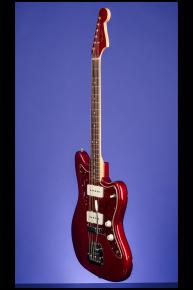An All Original 'Spaghetti Logo' Candy Apple Red Jazzmaster
Leo's Favorite Custom Color
1963 Fender Jazzmaster
This wonderful surfing guitar weighs just 8.00 lbs. and has a contoured solid alder body. One-piece maple neck with a nut width of just over 1 5/8 inches, a scale length of 25 1/2 inches and a very comfortable medium-to-thick profile. Rosewood veneer fretboard with 21 original medium-to-thin frets and inlaid pearl dot position markers. Large headstock with matching Candy Apple Red finish and decal with "Fender" 'spaghetti' logo in gold with black trim, "Jazzmaster" in black beside it, and "With Synchronized Floating Tremolo" and four patent numbers and one design number in black in two lines below it. "Offset Contour Body Pat. Pending" decal at the ball end of the headstock. Single "butterfly" string tree with nylon spacer. The neck is stamped "4 DEC 63B" and the neck pocket has "12-63" written in black ink. Individual single-line Kluson Deluxe tuners with oval metal buttons (stamped on the underside "D-169400 / Patent No." Four-bolt neck plate with serial number "L27974" between the top two screws. Two grey-bottom Jazzmaster pickups with outputs of 7.93k and 8.15k. The potentiometers are stamped "137 6410" and "304 6421" (CTS March 1964 and Stackpole May 1964). Four-layer (tortoiseshell over white & black) celluloid pickguard with thirteen screws. Two controls (master volume, master tone) plus three-way pickup selector switch and jack socket on the treble side of the pickguard, two roller knobs (volume, tone) plus two-way circuit selector (rhythm/lead) slide switch on the bass side of the pickguard. White plastic "Witch Hat" knobs with metal tops. Jazzmaster bridge and integrated tailpiece and tremolo. There are a few small surface chips on the treble edge and the back of the body. Otherwise this fifty-three year old Jazzmaster is as near mint (9.25) condition as one could wish for. The Candy Apple Red (over Silver) is as fresh as it was when it left the factory. Complete with the original tremolo arm, bridge cover and even the original twelve page Fender Jazzmaster Instruction Manual/Hang Tag. Housed in the original Fender three-latch rectangular tan hardshell case with brown leather ends and dark orange plush lining (9.00). This actual guitar appears in Werner's List on p. 37 "L27974 J-Master CAR"
"Candy Apple Red (CAR), first introduced in 1963, was alleged to be Leo's favorite custom color, and hence was a very popular Fender color. It was also a "true" custom color. CAR was not simply a 1960's car color used on guitars. It was an actual custom finished used by Fender and custom paint shops. It was certainly the most difficult color for Fender to apply since it required an additional step of using a metallic base-coat before a translucent red color coat. All other metallic Fender finishes have the color and metallic particles mixed together into a single paint unit. "Candy" colors have a metallic base coat applied first. This is followed by a translucent color coat, and finally by a clear coat. This gives a much deeper metallic look to the finish because the color is not mixed with the metallic sparkles. The metallic particles shine through the translucent color coat instead of being surrounded by the color which stifles their effect. Also by separating the metallic particles and color, larger metallic particles could be used in the base-coat. This also enhanced the metallic effect. Fender typically used a white primer under the metallic base-coat to limit the amount of basecoat needed. The base coat used by Fender was usually silver until 1965/1966, and gold starting some time in 1966. The final finish looks slightly different depending on the color of the base-coat. Gold base-coat makes the CAR look more maroon and turns brownish-red with age. Silver is the much cooler base-coat as the color is more red than maroon and ages better." (http://www.guitarhq.com/fenderc.html)
"The Jazzmaster first appeared in Fender sales material during 1958, and at some $50 more than the Strat it became the new top-of-the-line model...Immediately striking to the electric guitarist of 1958 was the Jazzmaster's unusual offset-waist body shape...For the first time on a Fender, the Jazzmaster featured a separate rosewood fingerboard glued to the customary maple neck...The Jazzmaster's floating vibrato system was new, too, and had a tricky 'lock-off' facility aimed at preventing tuning problems if a string should break. The controls were certainly elaborate for the time…A small slide-switch selected between two individual circuits, offering player-preset rhythm and lead sounds. The idea was a good one: the ability to set up a rhythm sound and a lead sound, and switch between them. But the system seemed over-complicated to players brought up on straightforward volume and tone controls. The sound of the Jazzmaster was richer and warmer than players were used to from Fender. The name Jazzmaster had not been chosen at random, for Fender was aiming this different tone at jazz players, who at the time largely preferred hollowbody electrics, and principally those by Gibson. However, jazz guitarists found little appeal in this new, rather difficult solidbody guitar -- and mainstream Fender players largely stayed with their Stratocasters and Telecasters" (Tony Bacon, 50 Years of Fender, p. 26). Much to Fender's surprise, however, the Jazzmaster turned into the best surf guitar ever conceived.













